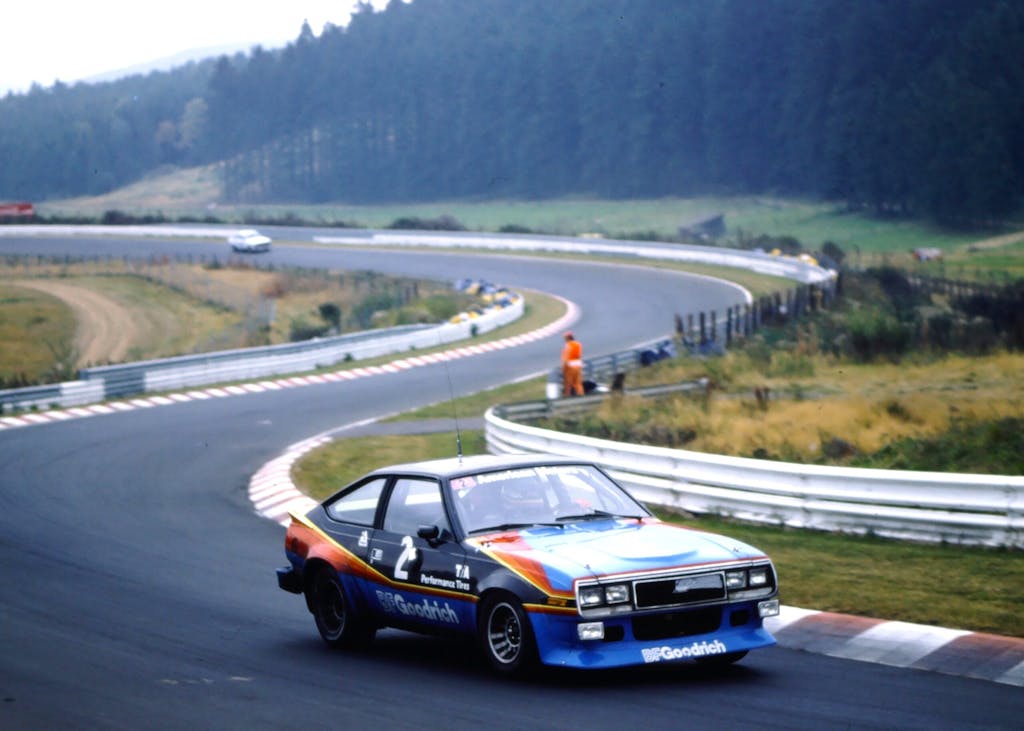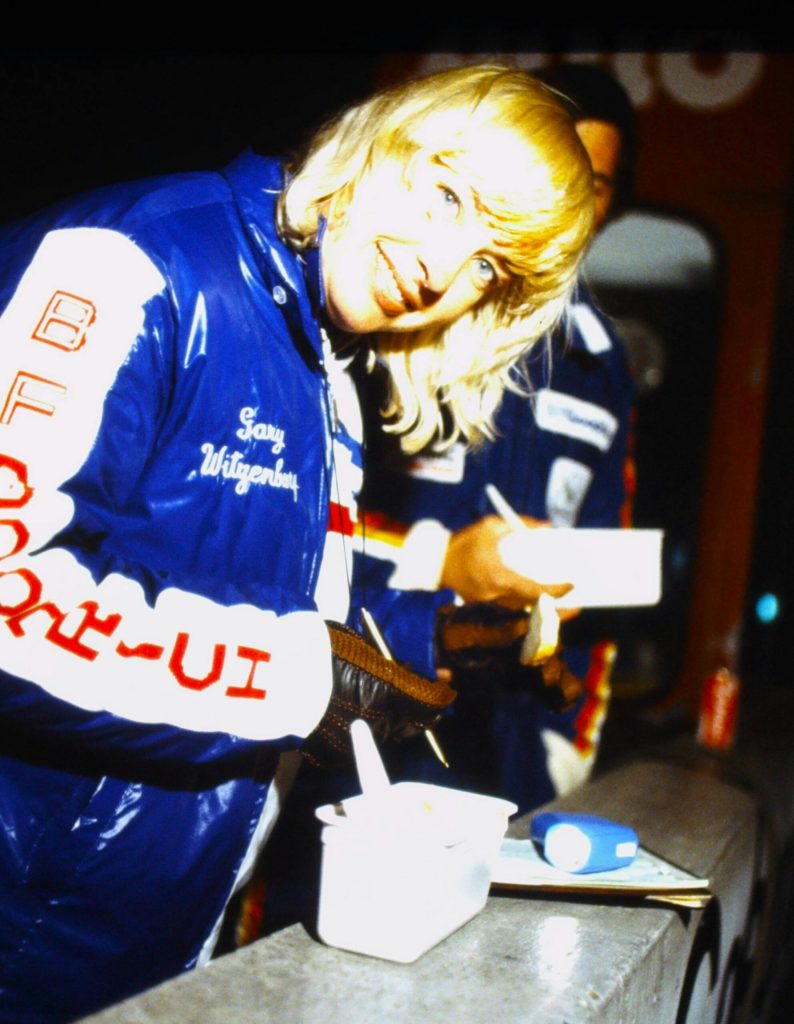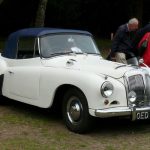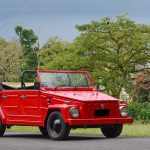I was flogging the big Mercedes as fast as it would go, considering I hadn’t a clue which way the course went, artfully dodging occasional cars, bicycles, and buses full of tourists. Beside me was my friend (and future wife) Jill – surely the best and bravest woman I knew – trying to read a huge course map. A few laps later she was taking notes as I thrashed the car around: “Tight esses with kerbing at 3km,” “Medium right after jump, then fast esses.”
The Nürburgring is the legendary racing course built around the ruins of the Nürburg Castle in the Eifel Mountains, about an hour south of Bonn, Germany. Completed in 1927, it winds, climbs, and dives for 22.835km (14.2 dizzying miles) before rejoining itself at its grandstand-lined start/finish straightaway.


Of all the world’s road-racing tracks, it remains the one most loved and feared by those who face it. In 52 years of history prior to our October 1979 visit, it had left more than its share of broken cars, bodies, and spirits along its bordering guardrails and trees, and it remains today the ultimate paved-course challenge for man and machine. Many of the world’s automakers use it as a test track, especially for higher-performance cars. But it has not hosted the German Formula 1 Grand Prix since Niki Lauda’s near-fatal crash in 1976. An all-new 4.1-mile track had been built for that purpose just south of the original.
Anyone could drive the course for 10 DM (about £3) a lap, and if you damaged your car or yourself . . . your problem, not theirs. Our six AMC/BF Goodrich drivers were trying to learn it in rental cars (three six-cylinder, automatic Mercedes and a four-cylinder, four-speed Opel) in four open-to-the-public days prior to competing in the traditional 24-hour race. BFG was paying for our track time by the hour, so we had virtually unlimited opportunity to practise.

Most of its 176 turns were so blind – just around other curves, or over hill crests – that you couldn’t see how sharp they were, or even which way they went until you got there, and there were precious few landmarks to signal what was coming next. It might be the circular “Karussell” bowl turn, which has its lower lane banked for higher speed – best to drop down into that banked lane at its entrance, then pop out just before exiting. Same for another shorter, tighter two-level curve we called “Little Karussell.” And its long, long back straight offered plenty of top-gear, top-rpm test time before braking for turn one just past the pits.
Unable to pronounce many of the German place names around the course, we made up our own: “Coming up through this chute, you see three speakers on a pole, and that’s the really hard left-right.” Or “There’s a tower like Fort Apache just before the left leading to the Little Karussell.” Two haul-ass rights over a brow near our inn became “Hotel.” A fast, scary, triple-apex right with a rail separating the track from the valley below was “Guardrail.” One trash can told us that the next series of blind curves could be taken flat-out . . . then someone moved it. But that section remained “Trash-can Turn.”
By a great stroke of luck, our innkeeper knew a true Ringmeister, a small, weathered man in his 50s named Heinz Hennerici. Heinz had run and won countless races there despite having lost his left arm in World War II, and he was incredible! He’d pile three of us into his stick-shift BMW and do everything with his right hand – moving the wheel just enough to arc smoothly through each apex, holding it with a knee while shifting, all the time gesturing wildly and barking instructions like a drill sergeant. He didn’t speak English, and none of us knew German, but that didn’t seem to matter. Out of his car, we communicated through BFG’s interpreters.
We rode with Heinz, and he rode with us. We followed Heinz, and he followed us. We’d arrived worrying that there’d be no way to really learn the whole track before the race. But by Friday, thanks to Heinz, I knew most every inch of it and the quickest way around and could roll it through my mind like a newsreel. That did wonders for my confidence.
How We Got There

For me, this wondrous adventure had begun with a phone call from BF Goodrich public relations man Gary Pace: “Would you be interested in co-driving the Nürburgring 24 Hour? We think we’ll be fairly competitive.” Really? Why me? Probably because I was a well-published auto writer with racing experience, and some success at it. I was even at the time competing in the US in IMSA’s RS (Radial Sedan) pro series with a Datsun 710 against Team Highball’s very quick six-cylinder AMC Spirits, so I guess they knew I was an OK driver. When do we leave?
The plan was to run a pair of BFG-sponsored cars and make a film of the effort. It would be the first time an American team had taken on this traditional Nürburgring event, which was part of a Trans-European Endurance Series for Group One (improved production) sedans. Our cars would be 5.0-litre V8 AMXs, prepared by AMC/Levi’s Team Highball. The other drivers would be Highball team leader Amos Johnson, engine builder and ace racer Dennis Shaw, Mazda hotshoe (and IMSA champion, and co-inventor of the HANS device) Jim Downing, (pre-Indy) Kelly Girl series regular Lyn St. James, and actor/amateur racer James Brolin. And we would be on street radials.

BFG had been racing its performance street tyres beginning with a “Radial Tirebird” SCCA A-Sedan in 1970, and that car had made the National Championship “Runoffs” the following year. Then they teamed with John Greenwood and his killer Corvettes and scored good international endurance racing results in ’72 and ’73. Then they added off-road racing, Pike’s Peak, performance rallying, and tractor-pulling, all with success.
As an American tyre company taking an American team to Europe, Goodrich wanted to run American cars, and our 1979 American Motors AMXs were V8-powered, four-speed-manual AMC Spirits with stiffer suspension, spoilers front and rear, and fat (for that era) tyres under flared wings . . . hotted-up versions of the compact coupe that had just replaced the quirky Gremlin. Thanks to an AMC team in the UK, the AMX was already homologated for FIA international Group One competition in a configuration that could be competitive, and a pair could be built and prepped quickly combining parts support from Jim Rader’s AMC Performance Group and experience from Team Highball’s successful IMSA RS Spirit effort.
Would they be fast enough around the Nürburgring to keep us from looking foolish? Those twin-cam Fords, BMWs, and Opels of the time were quick and agile. Johnson and Pace figured we could win the race with luck, but I had my doubts. I thought we might be faster on the straights but would likely get out-braked and out-cornered on street radials vs. racing slicks.

The BFG entourage trickled into our AM Ring Inn headquarters early in the first week of October. But something very important was missing – the transporter and its contents. German customs had impounded the whole shebang at the border because of some discrepancy in the paperwork. Rig drivers Ankrom and DeAngelo were getting nowhere trying to negotiate their way in, and the whole programme seemed in peril. After numerous frantic phone calls to headquarters in Akron, Ohio, to brokers in New York and Antwerp, and to German customs, the two nervous drivers sweating it out at the border (they couldn’t move either way) had accomplished nothing. So, Pace dispatched himself late Monday night to pull off a rescue.
Twenty-four jittery hours later, they finally arrived. “I never kissed so much ass in my life,” he reported, exhausted but jubilant. They had to back up to a dock, unload the cars, parts, tyres, tools, T-shirts, jackets, caps, decals, even the shop rags, and inventory each by type and size. They were told the rig was too high, too long, too wide, and too heavy to enter the country, and he had to make a mad dash several miles away for a special permit, having to cry and cajole it out of a hostile woman official who must have been a descendant of Attila the Hun himself.
Thursday brought a welcome hour of exclusive track time for everyone to get at least one lap in our race cars while BFG’s cameras rolled and the crew worked to dial in our engines and chassis. The number 1 Johnson/Shaw/Brolin car was fairly good right off, but our Downing/St. James/Witzenburg number 2 seemed severely short on both power and brakes.

Friday took us through tech and registration with just one scare, when the tech inspectors objected to the location of our master electrical cutoff switch. Jeremy Nightingale from the British AMC team convinced them that it was right by the English translation of the rules even if theirs said something different. Then we got in a few more rental-car laps while the mechanics toiled and the film crew filmed.
After dinner was a drivers’ meeting to discuss the track, race strategy, and rules. For instance, we could stop on course to change a tyre or make repairs unassisted, but it had to be off the pavement and not near a turn, and it would be kaput if we left the car even for a short time. (Some small tools, tape, wire, spare parts, and a flashlight would be in our gloveboxes.) Refuelling would be done at civilian-type pumps near the pit entrance with engines off and helmets on, and we would have to push the car into the pits by ourselves if it wouldn’t restart.
The Race

The ’Ring has a reputation for nasty weather, often differing from one section to another, so no one was surprised when Saturday dawned cold, wet, and foggy. Practise time was cut short due to the fog, which (in typical Nürburgring style) was dangerously thick in some places, non-existent in others. Each driver managed the mandatory two practise laps, but the high-torque, short-wheelbase AMXs proved skittish and hard to drive smoothly in the wet. Our number 2 car was improved since Thursday, but with its more mildly tuned engine, taller axle ratio, and soft brakes it was still slower than number 1. Except for the brakes, this was intentional since number 1 was supposed to win. Our job in number 2 was to run a bit slower and be sure to finish.
With the drizzle stopped, the track dry, and the fog finally lifted, Johnson and Downing ran two laps of qualifying together to install us 20th and 21st on the 109-car grid. Their times were about 10:26 minutes compared to 9:38 for the pole-sitting 2.0-litre Ford Escort and 14:10 for the slowest 1.0-litre Austin Mini. Amos figured number 1 was good for 10:10 or so if pushed to the limit, which would be quite respectable on street rubber.
The 10 classes of cars were divided into three groups with three separate standing starts. Our group (the fastest, and first to start at 4pm sharp) consisted mostly of hot-dog Ford Escort 2000 RS’s and Capris and Opel Commodores and Kadett GTEs. The second was a mishmash of VW Rabbits and Siroccos, Audis, Toyotas, Alfas, Fiats, Hondas, and the like, some of them indecently quick. The third was more of the same with smaller displacements, plus a class for Renault 5s and another for diesel VW Rabbits.

Both AMXs (Johnson and Downing up) got off to good starts and completed lap one in 16th and 20th positions. They soon settled into comfortable paces, Amos lapping between 10:15 and 10:20, Jim in the 10:35-to-10:40 range in heavy traffic. There was one early scare when Amos radioed that he was stopped on course with a broken throttle cable, but it had merely slipped from its bracket. Both cars’ cables were subsequently securely taped in place on their first pit stops. The first two shifts were a short five laps to get a good handle on fuel consumption, but it was nearly dark when Brolin took over from Shaw at about six o’clock, and pitch black when I relieved St. James a few minutes later.
Surprise! The car handled beautifully, front tyres biting and turning into apexes with no troublesome understeer, rears spinning and sliding just slightly under power coming out. I found that I could corner with almost anyone and was faster on the straights than all but the very quickest cars, but I had to back off early and give a lot away under braking for tighter turns. The engine was better than it had been in morning practise and felt like it would run for weeks at our 5000rpm redline. But the seat was angled back too far for comfort, making me stretch for the wheel; the driving lights were aimed a bit low for long-distance vision at speed, and the brakes were still super-soft, feeling like there was air in the lines, despite much bleeding and adjusting before the start. At times, the pedal would go right to the floor and flash its bright red warning light when I needed brakes the most.

Consider racing on the tricky, treacherous Nürburgring, especially at night, with bad brakes. Traffic was bothersome, with slower cars – not knowing I was near brakeless – unintentionally getting in the way and the occasional faster one lighting up my mirrors. Which side was it on? Is it passing or just hovering? I would power past slower cars on a straight, then pump like mad trying to slow for the next turn while the cars I just passed climbed all over me looking for a way around. Some would re-pass going into slow turns, then hold me up through faster ones. Sometimes while trying to brake for a turn, a slower car would suddenly move over in front of me. I’d mash the pedal harder hoping for one last ounce of stopping power, the warning light flashing red in my face, then dodge one way or the other and miss it by millimetres. But if I started slowing a split-second late, I’d be sailing into a corner too fast, the outer guardrail looming up with nothing but air over the valley on its other side.
But it was after my first turn at the wheel that our real trouble began. Something in the chassis started coming adrift, and at one point it jerked Jim clean out of the Karussell and almost into the guardrail. He came in, the crew checked and tightened everything they could find and sent Lyn out. “I hope she gets back,” said Downing gravely. A few minutes later she radioed in with the same problem, which had given her a nasty spin and another near-miss with a guardrail in a flat-out left turn. In she came, under the crew went again, and out she went. “A little better,” she radioed, “but still bad in left turns. I’ll try to go the distance.”

Very luckily for me, our crew found and fixed the elusive problem – a loose right front camber adjustment, which would pop back into place and look OK in the pits – before my next shift, and our number 2 car handled perfectly again. Plus, its lights had been re-aimed and the seat was better adjusted, so I zipped around for the next two hours with only the barely functional brakes to worry me.
I found myself thoroughly enjoying driving at night with campfires dancing and flashbulbs popping in the trackside darkness. It took heavy concentration on the narrow field of vision in my powerful beams, with taillamps glowing warm red ahead, then changing abruptly to harsh white in my mirrors as I passed slower cars. We were going nearly as quickly as anyone now, and traffic was less of a problem with attrition cutting through the field. Amos and I ran together for a while, chatting on the radios and warning each other of the occasional wreck or oil on the track. It felt great to be part of a first-rate team effort! In the car, my 10-lap stints passed way too quickly; out of it, time seemed to drag. It got cold, everyone was shaking and shivering when not working, and I was nursing a worsening cold.

I tried to catch a quick nap between shifts but had trouble sleeping. I wanted to get back to the pits to know what was happening, and I couldn’t wait to get back into the car. While I was gone, number 1 yielded a second front shock and a rear spring bracket to the ’Ring’s torturous Karussell and suspension-pounding jumps, losing an hour while the crew welded the bracket and ripped replacement parts off of Nightingale’s street AMX. Our number 2 car got new brake linings and a fresh bleed. Jim reported the brakes were better for a while but going bad again.
In the confusion, they left Lyn out for 11 laps, and she ran out of gas on the long final straight. She tried the auxiliary pump (which had a lower pickup for just such an emergency), but it wouldn’t prime. She managed to coast within sight of the gas pumps, but no further. She kept cranking the starter. It fired and died, fired and died. The officials were watching to see if she would get out and push. She tried the starter one last time . . . and it fired and roared! She popped the clutch and burned rubber all the way to the pumps.
The night ground on with most spectators too tired or drunk to pay attention. The small groups of safety workers kept their cold, lonely vigils behind the track-side rails. We powered out of blind turns and plunged over hilltops, never knowing whether there would be an ice-like patch of oil or a wrecked car just out of sight in the darkness. At daybreak, a fine layer of dew slickened the track surface while patches of heavy fog settled in to challenge visibility. We had fallen well behind with our brake and suspension troubles but had worked our way back past mid-field by daybreak. Dirt framed the crewmen’s sunken, bloodshot eyes. Everyone was exhausted, but it was beginning to look like we could make the distance.

Amos and I got the dreaded 6am to 8am shift, when the course could be especially treacherous with dew and fog, but we lucked out with dry track all the way around and heavy fog only in the start/finish area. I shot some dawn footage, per instructions, with the film crew’s in-car camera. It was overcast, so not much of a sunrise, but it felt glorious to see the sky light up while I was driving. Relaxed and comfortable but near brakeless, I was doing 10:40s and clocked one lap at a respectable 10:35.
Instead of sleeping, I showered and traded my sweat-soaked Nomex undies for fresh ones before my last turn at the wheel. The number 1 car had broken yet another shock and took our last spare. Its clutch was slipping badly, and its engine was using a lot of oil. Both front shocks and the brakes were all but gone in our number 2 car, to the point where pumping the pedal dragged the front spoiler with little effect on speed. I backed off a bit trying to cool the brakes, but it didn’t help. Five hours to go, we were 32nd overall and number 1 was 44th. I counted 65 cars still circulating.
Amos and Lyn were out for the final hour, lights on, circulating together as a light drizzle slickened the track. Workers and spectators around the course were waving and cheering, impressed by how well we had run on our street tyres, and that our funny American cars were still running at all. Strangely, cars started lining up just short of the finish with a few minutes to go, not wanting to risk another 14 miles, while some threaded their way through to log one last lap.

When the countdown clock struck zero, this whole mob rolled over the line, looking more like a massive start than a finish, to the cheers of spectators, workers, officials, and especially the exhausted crews. Our film crew’s helicopter marked our cars’ progress down the long final straight to, at last, the waving chequered flag, and the whole BFG bunch was as excited and emotional as if we’d won the thing, running around, babbling incoherently, hugging and kissing each other like crazy people. Suddenly the sun was out, and my cold was much better.
We had done it! We hadn’t won, but BFG’s expensive gamble had paid off nonetheless. Our amazing Team Highball crew had kept us going through all our mechanical troubles, and we’d finished 25th and 43rd of the 109 that started (and 70-some still running) but first and second in our over-3500cc class, with both cars looking tired but undamaged.

We had challenged the legendary Nürburgring, fought it to a draw, and learnt to love and respect it as a potent adversary. Our BFG T/A street radials had performed flawlessly, going eight hours and more between routine changes without a failure or trouble of any kind. We’d competed respectably enough in our first try at European endurance racing to fly home proud and happy. Our movie crew had recorded the whole remarkable experience on film, and we’d recorded a great adventure in our personal memory banks.
Le Mans, anyone?










Well said. Tyres are an area where people go overboard needlessly, all too often. Having said that, when making a mistake on a wet and greasy motorway slip road bend, Pirellis are total sweethearts.